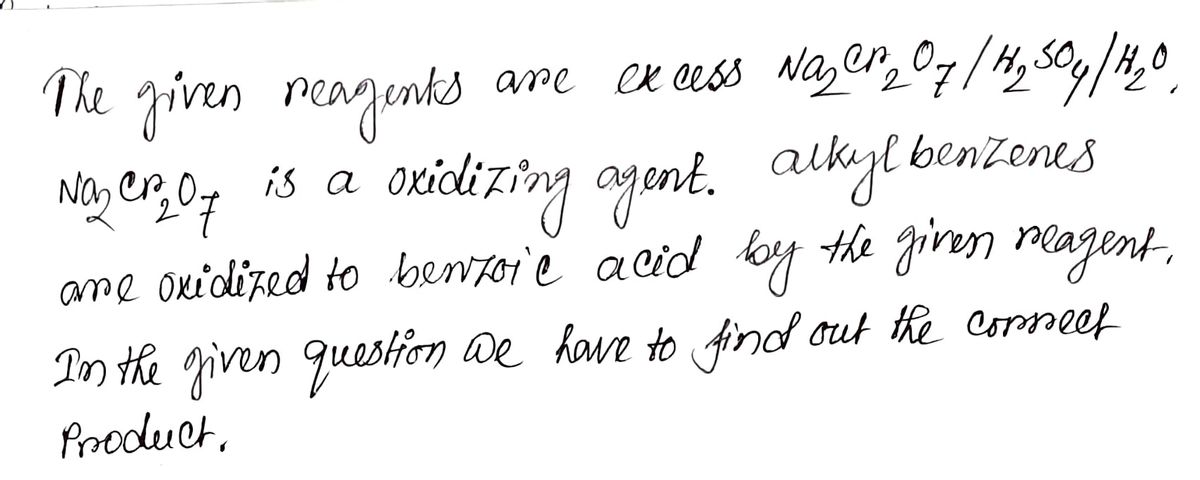Chemistry
10th Edition
ISBN:9781305957404
Author:Steven S. Zumdahl, Susan A. Zumdahl, Donald J. DeCoste
Publisher:Steven S. Zumdahl, Susan A. Zumdahl, Donald J. DeCoste
Chapter1: Chemical Foundations
Section: Chapter Questions
Problem 1RQ: Define and explain the differences between the following terms. a. law and theory b. theory and...
Related questions
Question
Synthesis: draw/provide the likely organic products generated. With attention to regiospecificity and stereochemistry indicating ALL likely products( major,minor and trace)

Transcribed Image Text:In the presented chemical reaction, naphthalene undergoes oxidation in the presence of an oxidizing agent. The reaction conditions are specified as an excess of sodium dichromate (Na₂Cr₂O₇) in sulfuric acid (H₂SO₄) solution, with water (H₂O) also present.
**Chemical Reaction:**
1. **Starting Material:**
- Naphthalene (represented by a structure with two fused benzene rings).
2. **Reagents:**
- Excess Na₂Cr₂O₇
- H₂SO₄ (indicated as acid)
- H₂O
3. **Product:**
- The product is a carboxylic acid derivative of a single benzene ring with a carboxyl (–COOH) group attached. The structure indicates the oxidation of one of the rings, resulting in phthalic acid.
The chemical transformation depicted is typical for the oxidation of aromatic compounds, where strong oxidizing agents such as sodium dichromate are used to introduce carboxylic acid functionalities.
Expert Solution
Step 1

Step by step
Solved in 2 steps with 2 images

Knowledge Booster
Learn more about
Need a deep-dive on the concept behind this application? Look no further. Learn more about this topic, chemistry and related others by exploring similar questions and additional content below.Recommended textbooks for you

Chemistry
Chemistry
ISBN:
9781305957404
Author:
Steven S. Zumdahl, Susan A. Zumdahl, Donald J. DeCoste
Publisher:
Cengage Learning

Chemistry
Chemistry
ISBN:
9781259911156
Author:
Raymond Chang Dr., Jason Overby Professor
Publisher:
McGraw-Hill Education

Principles of Instrumental Analysis
Chemistry
ISBN:
9781305577213
Author:
Douglas A. Skoog, F. James Holler, Stanley R. Crouch
Publisher:
Cengage Learning

Chemistry
Chemistry
ISBN:
9781305957404
Author:
Steven S. Zumdahl, Susan A. Zumdahl, Donald J. DeCoste
Publisher:
Cengage Learning

Chemistry
Chemistry
ISBN:
9781259911156
Author:
Raymond Chang Dr., Jason Overby Professor
Publisher:
McGraw-Hill Education

Principles of Instrumental Analysis
Chemistry
ISBN:
9781305577213
Author:
Douglas A. Skoog, F. James Holler, Stanley R. Crouch
Publisher:
Cengage Learning

Organic Chemistry
Chemistry
ISBN:
9780078021558
Author:
Janice Gorzynski Smith Dr.
Publisher:
McGraw-Hill Education

Chemistry: Principles and Reactions
Chemistry
ISBN:
9781305079373
Author:
William L. Masterton, Cecile N. Hurley
Publisher:
Cengage Learning

Elementary Principles of Chemical Processes, Bind…
Chemistry
ISBN:
9781118431221
Author:
Richard M. Felder, Ronald W. Rousseau, Lisa G. Bullard
Publisher:
WILEY